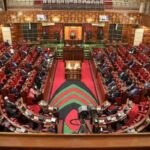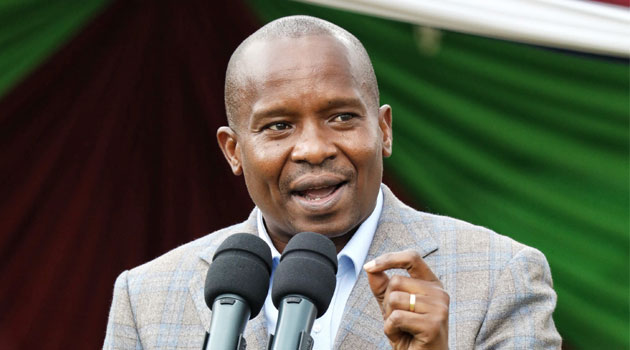Income inequality rose to 38.9% in 2021 from 35.8% a year earlier, according to data from the Kenya National Bureau of Statistics released on Thursday.
It is measured using the Gini coefficient and varies from 0%, representing perfect equality, to 100%, representing the most unequal distribution.
Inequality fell during the pandemic as higher incomes suffered a greater share of income losses, while the poorest benefited from a temporary benefit increase that ends in early 2021.
KNBS data show the extent to which wealth distribution is skewed in favor of smaller groups, with Nairobi having the highest income inequality among Kenya’s decentralized institutions. Analysts see a Gini coefficient of 40% as social dissatisfaction may peak.
“Overall, the poorest quintile accounted for 7.4% of total consumption, while the richest quintile accounted for 42.2% of consumption, suggesting significant welfare inequalities,” KNBS said. , said the report, which also showed that the number of poor Kenyans had fallen by more than one million. .
Part of the income inequality is attributed to the early centralized government system that determined the distribution of resources since independence.
Analysts say the county needs to provide incentives to attract private investors to distribute wealth, raising hopes that the decentralized government system launched in 2013 will resolve economic imbalances. .
Slow economic activity over the past three years has exacerbated income inequality, with job losses and stagnating wages hitting the middle class the hardest. As the country’s economy grows, wealth is concentrated in the hands of a small percentage of the population.
The gap between rich and poor, based on the Gini coefficient, widened from 39.1% in 2016 to 40.7% in 2019.
In 2020, when the COVID-19 pandemic hit Kenya’s economy hardest, inequality fell by 35.8%.
Covid-19 is causing an economic storm, hitting the poor and vulnerable hardest, with the pandemic pushing more than 100 million people into extreme poverty, according to the World Bank warned.
Development NGO Oxfam International said it could take more than a decade for the number of people living in poverty to return to pre-crisis levels. Globally, there has been a trend toward widening wealth inequality between the rich and the poor during and after the pandemic.
Billionaires, including Amazon’s Jeff Bezos and Tesla founder Elon Musk, saw their wealth skyrocket during and after the pandemic, while the world’s poor have endured years of hardship.
In response, the charity Oxfam issued a call for action to tackle inequality.
Kenyan President William Ruto won last August’s hard-fought elections with a goal of lifting millions out of poverty, but the country faces the challenges of a high cost of living and mounting debt repayments.
A fifth of the country’s richest population accounts for more than 40% of the country’s total spending, according to a poverty report released Thursday. Interestingly, according to official statistics, Kenya’s richest province, Nairobi, and poorest province, Turkana, have the highest and second highest inequality levels respectively.
Inequality in her two counties is higher than the nation as a whole.
Kenya’s capital and commercial center, Nairobi, has the widest gap between rich and poor, with a Gini coefficient of 40.9%, crossing the social unrest red line.
Turkana was 39.9%, Nadi 36.8%, Kitui 35.7%, Machakos 35.3% and Meru 35.1%.
The district with the lowest inequality is Vihiga with a Gini coefficient of 21.1%, followed by Makueni 22.6%, Bomet 23%, Busia 23.7% and Nyandarua 23.8%.
The number of people with a net worth of Ks620 million (US$5 million) or more in Kenya increased to 1,890 in a decade, and the number of $1 billionaires more than doubled in the decade to 2022 bottom.
That’s according to a report by Oxfam, Patriotic Billionaires, the Policy Research Institute, and the Alliance to Fight Inequality, with data from Forbes and WealthX.
Of the 1,890, 130 have a net worth of over Ksh 6.2 billion (US$ 50 million) and a total wealth of Ksh 2.3 trillion (US$ 18.7 billion).
According to the report, since 2012, the number of Kenyans with a net worth of over 620 million kronor has increased by 72.4%, while the number of Kenyans with a net worth of over US$6.2 billion has increased by 64.3%. The report shows that taxing the world’s ultra-rich could bring in as much as 210.8 trillion Kenyan shillings ($1.7 trillion) to fighting inequality.
The report found that in Kenya, a wealth tax of 2 percent on millionaires and 3 percent on individuals with wealth above Ksal 6.2 billion would generate an annual income of Ksal 90.5 billion ($730 million). It suggests that the numbers are enough to increase spending on education and health care. 14% x 34.3%.
Kenya has no wealth tax, and parliamentary finance bills propose raising the top income tax rate from 30% to 35% for workers earning more than 500,000 shillings a month.
The finance bill, which includes higher taxes on fuel, remittances and housing, has drawn harsh criticism from officials and political opponents who say the cost of living is already too high.





























